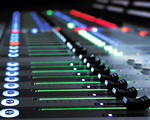On practically every project we work on that has a significant sound system, we have a discussion with the stakeholders about whether the main mixing console should be an analog board or a digital board. In a nutshell, we can boil the discussion down to 3 main points… Price, Flexibility, and Ease of Use. Here’s why…
- Price
- Of course it all rides on what you can afford. In the less expensive category (let’s say under $7,500) an analog board and associated wiring will just about always be less expensive. As we move up to more expensive consoles, the digital console becomes more cost competitive. At the top end of the spectrum, an excellent digital console will probably cost less than its analog counterpart.
- Flexibility
- One of the huge benefits of a digital console is the ability to patch almost any input to any channel on the board. And pretty much every digital console offers the ability to save presets to both the board and to an external flash drive. This allows multiple shows to be rehearsed and programmed into the console and recalled with just a few key strokes. It also means that if anyone has tampered with your board since rehearsal, you can restore your entire mix in a matter of seconds. Yet the analog console still has one real advantage over the digital console. On the analog board all your channels and settings are visible at once. Every knob and fader can be seen at a glance, and you can put your fingers on them instantly, while the digital consoles (depending on size caliber) will typically require the operator to press buttons and/or switch layers to make the needed changes.
- Ease of Use
- The final consideration is the ease of use. Plain and simple, you get what you pay for. Especially on the digital side of the discussion, the less expensive consoles are harder to operate. The less costly digital board doesn’t offer as much user interface (to save money) and thus can be a bit more challenging to operate, as the operator has to navigate through more screens, layers, and menus to get to the needed controls. However, the more advanced digital consoles tend to have easier access to get where you need to go. The analog board has everything up so you can see it. It’s nice if you know what it all does, but it can also be intimidating if you are a less experienced operator.
So what’s the right choice for your application? Well, it depends. Anyone who is in the market for a new mixing console needs to consider all of the pros and cons. At Acoustics By Design we specialize in helping people analyze all of the options and make the best choice for their application. Since we don’t sell any products, we are able to offer objective advice based on your best interests, not based on monthly sales goals. We are interested in what your opinions here. What do you think about it? What are other important considerations in the analog versus digital mixing board discussion?

I think this post is pretty much clarifying, still i’d like to ad two essential things that would make me opt for an expensive digital console instead of an expensive analog console in a Live situation:
With a digital console we are able to save and recall programs with the configuration of the sound events we are working on, which safe lots of time. One other very useful issue is the possibility of inserting high quality dynamic processors for individual channels.